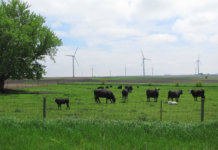 (Editor's note: The following article was reprinted with permission by the American Wind Energy Association.)
(Editor's note: The following article was reprinted with permission by the American Wind Energy Association.)
Low-cost, zero-emission wind energy will become even more valuable as states and utilities develop plans to cost-effectively reduce carbon pollution to comply with Environmental Protection Agency's (EPA) Clean Power Plan, according to new economic analysis from the Energy Information Administration (EIA), a nonpartisan branch of the U.S. Department of Energy (DOE).
EIA's analysis modeled a range of options for complying with EPA's proposed rule across a variety of scenarios, and wind energy consistently emerged as the lowest-cost option for reducing emissions.
World Resources Institute (WRI) also released analysis that looked at all economy-wide options for reducing carbon pollution and found that, thanks to recent cost declines, renewable energy is poised to make the largest contributions to emissions reductions. In WRI's optimal energy mix scenarios, renewable energy grew to provide 27% – 28% of electricity in 2030 and 36% – 38% in 2040.
These findings validate comments Energy Secretary Ernest Moniz made last week noting wind energy's recent cost reductions and saying, ‘We believe very much the central role of wind in meeting our climate challenges, and we're very committed in this direction.’
EIA's analysis shows that states and utilities can cost-effectively achieve the Clean Power Plan, particularly if wind energy provides a large share of the pollution reductions. As a result, states and grid operators should begin planning today for the policies and transmission upgrades that will enable them to make full use of their best wind energy resources.
Thanks to its combination of low cost and zero emissions, wind energy played a dominant role in complying with the Clean Power Plan in EIA's analysis. By adding 317 million MWh by the year 2030 compared to a scenario without the Clean Power Plan in place, wind energy accounted for more than half of the optimal compliance mix. Energy efficiency was second, contributing savings of 107 million MWh toward meeting the Clean Power Plan, followed by solar at 77 million MWh and then natural gas at 58 million MWh.
Change in output under Clean Power Plan relative to reference case

Wind energy's large role in the economically optimal generation mix is not surprising. Thanks to technological advances that have drastically reduced its cost, wind energy has emerged as the lowest-cost generation option for reducing emissions.
Zero-emission wind energy also provides states with valuable flexibility for finding the optimal energy mix, relative to low-carbon energy sources that have some emissions.
For example, because one MWh of gas generation emits nearly half as much CO2 as a MWh of coal generation, nearly twice as many megawatt-hours of coal generation must be displaced to achieve the same level of emissions reductions versus if a zero-emission compliance option were used instead.
As a result, zero-emission resources such as wind, provide states with the greatest flexibility for complying with the Clean Power Plan and reduce the magnitude of changes that are required in the generation mix. Thanks in part to this flexibility, EIA's analysis found that the highest wind deployment scenario saw 12 GW fewer of coal plants retire than in the base Clean Power Plan case.
In addition, zero-fuel-cost wind energy plays a valuable role in protecting consumers from increases in the price of other fuels. Stably priced wind energy protects consumers from fuel price increases much like a fixed-rate mortgage protects consumers against interest rate volatility.
For example, EIA's analysis shows that natural gas prices increase by more than a dollar when gas is the primary tool used for Clean Power Plan compliance, whereas natural gas prices tend to actually decrease when wind energy is the primary compliance tool. This not only helps to keep electricity prices low, but also reduces costs across a variety of industries and activities that use natural gas, including fertilizer production, chemical manufacturing and home heating.
Similarly, DOE's recent Wind Vision analysis found that natural gas prices were lower and electricity prices were 20% less sensitive to fluctuations in natural gas prices in a scenario with a large amount of wind energy.
EIA's analysis saw a large role for wind across more than a dozen different scenarios. As shown below, EIA saw a large amount of wind deployment in all scenarios it examined, even with low gas prices, more use of energy efficiency and greater use of nuclear energy. As a result, states and utilities should look to wind energy as a "no-regrets" option that will be valuable under any scenario for unexpected market changes, creating further impetus for states and grid operators to begin planning now for infrastructure to connect cost-effective wind.

As shown in the chart above, the scenario with national cooperation and trade yielded the greatest amount of incremental wind energy deployment (130 GW), relative to the reference case. Among other changes, this scenario saw the nation's best wind energy resources put to use. Consumer electricity prices were $1/MWh-$2/MWh lower in this scenario compared to the base Clean Power Plan case, while national GDP was higher by $17.5 billion annually on average over the 2020-2030 time frame.
EIA's analysis found the Clean Power Plan would greatly reduce pollution, with electric sector mercury emissions cut by 35% (4460 pounds), nitrogen oxides by 43% (670,000 tons), sulfur dioxide by 40% (580,000 tons), and carbon dioxide by 27% (581 million metric tons).
The wind energy opportunity identified in EIA's analysis is likely conservative, as it does not account for changes that the EPA has proposed to the rule that are expected to expand wind energy's role even further. EIA's analysis should provide a critical tool for states, utilities and grid operators to begin planning the policies and infrastructure upgrades that will allow them to put their wind resources to full use and most cost-effectively comply with the Clean Power Plan.
Michael Goggin is senior director of research at the American Wind Energy Association. He can be reached at mgoggin@awea.org.



